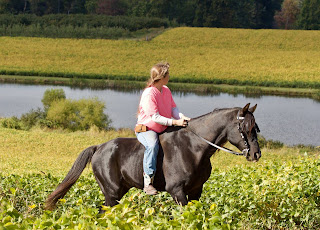- Get link
- Other Apps
You will see the term natural horsemanship a lot these days. Less commonly, you will see people discussing conscious horsemanship. I consider myself a student of the horse, and a follower of conscious horsemanship. Here are what I see as the drawback and advantages to each approach. Natural horsemanship techniques typically rely on a combination of desensitizing, habituation, dominance and repetition.
Taking each of these components, lets take a closer look. Desensitizing equals removing sensitivity. Horses see, hear, smell, feel and sense much more than most people. Desensitizing is considered desirable in natural horsemanship because the process produces a calmer, less reactive horse. Personally, I value my horse’s superior senses and depend on my horse to notice things I wouldn’t. I also recognize that there will always be new and potentially scary situations in life, no matter how many objects and situations I would desensitize my horse to. So the question is whether teaching a horse not to react is better than teaching a horse to think through new situations. Another question is whether or not you prefer to depend on your horse’s senses to supplement your own.
Habituation. Habituation is the same as desensitizing.
Dominance is another common theme in natural horsemanship. Become the herd leader. Move your horse’s feet. Drive your horse. Send your horse on a circle in the round pen until he surrenders and joins up. If your horse refuses a request, turn up the pressure. Here I would ask, if you are building a relationship with someone, do you choose to have one person dominate the relationship, to lead without question? How would you feel in a relationship where your partner made all your decisions? How would it feel to not be allowed to say “no”? Can there be true partnership if one partner is not allowed to say “no”? How willing and eager can a horse be, without freedom to choose?
Repetition. I frequently see horses being drilled. Folks drill for 3 reasons that I can see – to reinforce a point, to perfect an exercise or to punish. Once an activity is learned, is there truly a benefit to repeating the lesson?
Another observation I have made about several natural horsemanship techniques is the gap between what is said and what is done. Using gentle words does not translate to gentle actions. I suggest paying attention to what is actually being done, and how the horse is reacting. For example: a carrot stick, a wand, a whip, a crop are all names for similar tools. If the tool is used to tap annoyingly until the horse moves away, or used to cause discomfort or pain, does a warm fuzzy name change the outcome? Pay attention to the obvious – your horse will tell you his/her feelings about the techniques and tools.
 I am not suggesting that we anthropomorphize horses. Horses are horses – people are people. I am however suggesting that horses are conscious beings capable of thought and feeling, and that partnership is only possible when the thoughts, feelings and boundaries of both parties are honored.
I am not suggesting that we anthropomorphize horses. Horses are horses – people are people. I am however suggesting that horses are conscious beings capable of thought and feeling, and that partnership is only possible when the thoughts, feelings and boundaries of both parties are honored.Allowing for our differences also means learning each other’s language. Would you deal with someone who spoke a different language than yours by shouting? By forcing? By repeating over and over? By creating discomfort and waiting for the person to fumble around until by accident they got the answer and relieved the discomfort? Or would you take the time to explain your request in a variety of ways until understood?
Brainwaves can be a good indicator of how a horse is responding to a given technique or interaction. Informal studies over the years using Electroencephalograms (EEGs) have shown beta, alpha, theta and delta brainwaves occurring together in both hemispheres during TTouch. TTEAM Ground obstacles produced beta brainwaves, indicative of analytical thinking. EEGs during petting, stroking, brushing and rest did not produce the mix of all 4 types of brainwaves in both hemispheres. These results suggest that the non-habitual movements and touches of TTEAM produce thinking horses and true learning.
With my horses, natural horsemanship techniques produced obedience, and horses that were subtly unhappy with the work and not as interested in spending time with me when given a choice. TTEAM produced calm, curious, trusting interested partners. So when someone asks me how TTEAM is different from other popular techniques, my answer is that for me TTEAM is about respectful willing partnership, conscious thought, and the right to say “no”.
- Get link
- Other Apps


Comments
Post a Comment